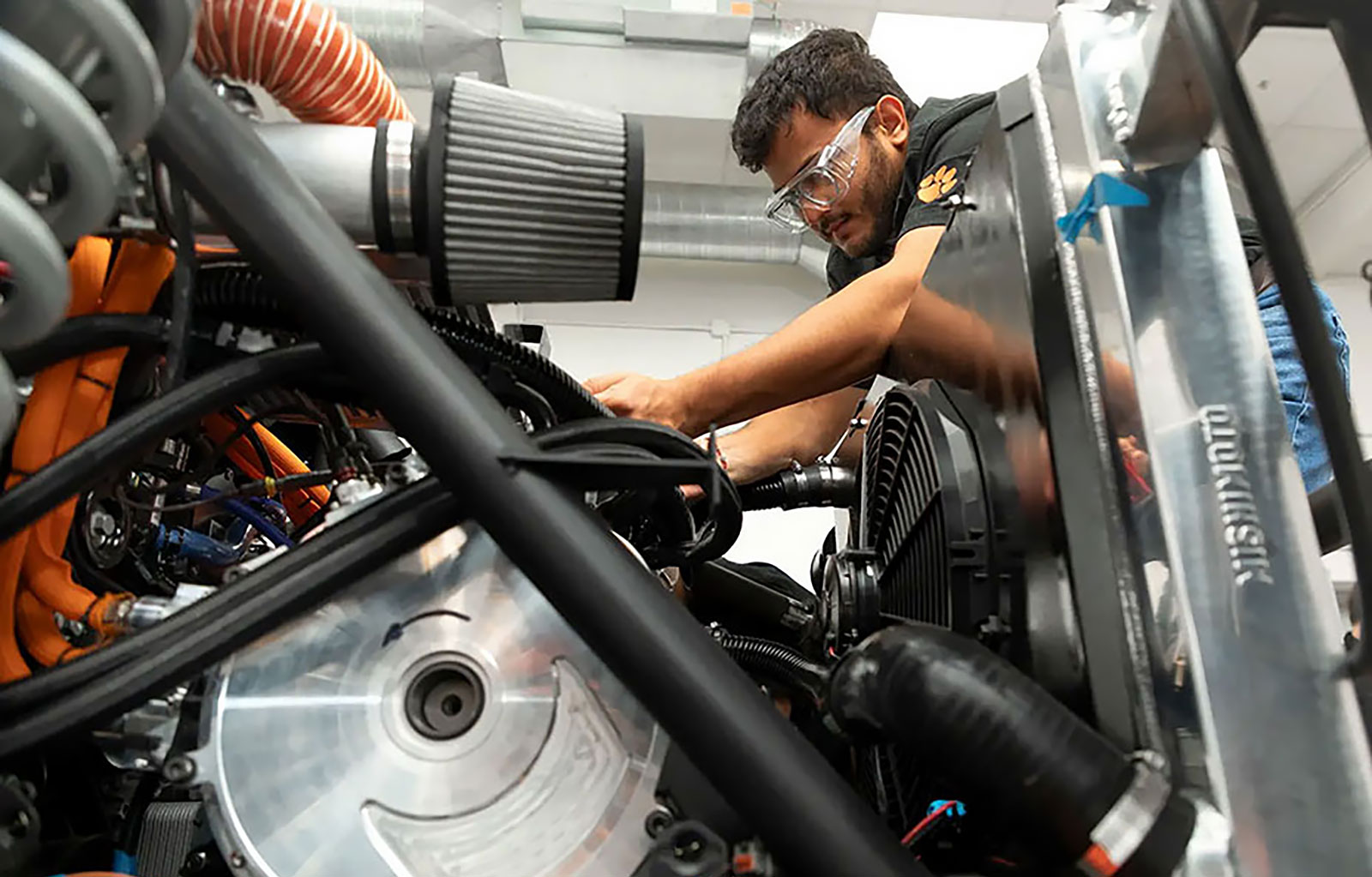Research Focus Area:
Propulsion Systems and Smart Energy

This focus area targets the development of efficient, resilient, and intelligent propulsion and energy systems tailored for off-road vehicles and full-scale vehicle configurations operating in harsh and dynamic environments. Research efforts span thermal management, mechanical systems, power electronics, and control strategies to enable reliable and mission-adaptive mobility.
Central to this work is the use of modeling and simulation frameworks to optimize performance across thermal, mechanical, and electrical domains. These simulations support the co-design of propulsion architectures and energy storage solutions, including hybrid-electric, battery, and emerging fuel-based systems, while accounting for variable terrain, load conditions, and mission profiles.
Additionally, this area explores the integration of next-generation energy sources, advanced storage systems, and intelligent power management to support dynamic vehicle demands under constrained or degraded conditions. Smart energy solutions enhance operational endurance, reduce logistical burdens, and ensure power availability for onboard subsystems such as autonomy, sensing, and communication.
A foundational component of this research is the application of digital engineering methodologies, including model-based systems engineering (MBSE), digital twins, and real-time co-simulation. These tools enable rapid design iteration, system-level trade space exploration, and lifecycle performance validation.
Focus Area Director
Beshah Ayalew
Professor, Department of Automotive Engineering
beshah@clemson.edu
Research Efforts
-
2.1 Electrical Power Architectures and Power Electronics
Principal Investigator: Chris Edrington
Motivation: Advanced modeling, control methodologies, power electronics, electrical power delivery architectures, high-speed simulation, HIL and understanding of degradation of components are critical in the development of NGCV
Goal: Develop reconfigurable power delivery architectures; power electronics enablers; HPC-based computing environment; cyber secure hardware and degradation abatement strategies
Approach: Exploring options for reconfigurable power architectures; modeling 2-level PEBB (power electronic building blocks for architecture enabling); modeling PEBB devices in HPC; cyber-secure power hardware; using Evidence Theory and Markov chains for degradation abatement algorithms
-
2.2a Energy Harvesting, Storage, and Fuel Processing
Principal Investigator: Joshua Tong
Motivation
- High volumetric and mass power density
- Intermediate-temperature operation (400- 700 °C)
- Flexible fuels (JP-8, hydrocarbons, biomass-derived fuels)
Goal: Develop an elevated-temperature all-solid-state Li-ion battery
Approach
- Materials computation, synthesis, and characterization
- Device component design, fabrication, and characterization
- Device modeling, design, manufacturing, and testing
-
2.2b High-Temperature Batteries with Engineered Microstructure
Principal Investigator: Stephen Creager
Motivation
- High power/ high energy density
-
High-temperature operation (suitable for 1050 °C cooling)
-
Safe (i.e., nonflammable, operates after physical damage)
Goal: Develop an elevated-temperature all-solid-state Li-ion battery
Approach
- Materials computation, synthesis, and characterization
- Device component design, fabrication, and characterization
- Device modeling, design, manufacturing, and testing
-
2.3 Power Generation and Propulsion Systems
Principal Investigator: Benjamin Lawler
Motivation
- Future unmanned military ground vehicles have unique powertrain requirements that are distinct from commercial on-road vehicles
- Military applications require high-power-density engines, have challenges associated with heat dissipation, and will be hybridized to meet electrical demands
- To meet these unique requirements, alternative combustion strategies, unconventional engine designs, and/or unique powertrain layouts may be required
Goal: Develop a simulation framework for engine and powertrain layout design to assess the suitability of various combustion strategies and powertrain layouts for different military applications, including experimental validation and hardware-in-the-loop (HIL) evaluation
Approach: Construct MATLAB/Simulink and GT-Suite models of various engine architectures and powertrain layouts, and develop a facility for HIL validation and demonstration
-
2.4 Integrated Transient Control and Thermal Management of Autonomous Off-Road Vehicle Propulsion Systems
Principal Investigator: Robert Prucka
Motivation
- 'Look-ahead' energy demand is available on autonomous vehicles
- Can be used to improve transient control of electro-mechanical power systems, especially in cooling-constrained situations
Goal
- Control algorithms that utilize energy preview information to simultaneously balance fuel consumption, electrical energy demand, ground performance and heat rejection
- Provide powertrain ‘availability’ for upcoming events
Approach: Real-time artificial intelligence-based optimization utilizing forward-looking autonomous vehicle perception information
-
2.5 Energy Management of Multi-Scale Vehicle Fleets
Principal Investigator: Beshah Ayalew
Motivation
- Fully burdened fuel cost is 100’s X that of civilian applications
- On-board electrical energy is now critical for various ISR, navigation and warfighter equipment
Goal
- Develop optimal energy sharing and utilization strategies for fleets of vehicles of varying scales operating in a resource-constrained environment
- Incorporate mobile/movable microgrids involving tactical vehicles
Approach
- Develop computable models and algorithms for energy-optimal motion plans for UGVs and UAVs
- Devise optimal design and operational control schemes for microgrids that support these vehicles while ensuring stable operation
-
2.22.6 Vehicle Propulsion Digital Twins: High-Performance Computing (HPC)-based Next Generation High-Fidelity Powertrain Co-Simulation for Ground Vehicle Systems
Principal Investigator: Shuangshuang Jin
Motivation: System modeling of electrified powertrains to understand the behaviors and interactions of each dynamic component is critical to the virtual prototyping of ground vehicle systems
Goal: Develop a high-performance computing-based high-fidelity powertrain co-simulation framework featuring high modular capability, scalable interface, concurrent execution, synchronized communication, and fast computation
Approach: Identify powertrain co-simulation use cases; declare I/O interfaces and interconnections; design Julia computing and HELICS-based co-simulation framework; develop hierarchical, distributed, and parallel simulations
-
2.22.7 Vehicle Propulsion Digital Twins and Hardware Integration in the Virtual Environment (HIVE)
Principal Investigator: Benjamin Lawler
Motivation: There is a need for an integrative effort across the VIPR-GS center to combine component submodels for engines, powertrain layouts and controls, energy storage devices, and power electronics
Goal: Develop a hardware-integrated virtual environment (HIVE) that can explore vehicles of varying scale, simulate powertrain architectures and their control strategies, and evaluate certain hardware components over mission profiles based on virtual vehicle characteristics
Approach: Collect propulsion system subcomponent models from the VIPR-GS center, integrate them into digital twins of military vehicles, and conduct HIL evaluations where either the virtual or physical components can be the subject of investigations
-
2.22.8 Multiscale Modeling of High-Temperature All-Solid-State Battery Cells and Packs
Principal Investigator: Apparao Rao
Motivation: To successfully develop high-temperature batteries with the desired architecture, it is essential to integrate experimental research with computational modeling over all relevant length scales from atomic-scale to continuum-scale
Goal: Develop multi-scale modeling frameworks for high-temperature battery cells and packs
Approach
- Elucidate the interface structures via experiments, atomic-scale and continuum-scale models
- Construct cell-level models to study the device performance using a bottom-up approach
- Derive pack-level degradation models
-
2.22.9 Stochastic Powertrain-Mobility Optimal Control for High Dynamic Off-Road Driving
Principal Investigator: Qilun Zhu
Motivation: Maximize off-road vehicle performance by combining powertrain and mobility control, considering perception uncertainties
Goal
- Short-horizon predictive control coordinating powertrain, steering, and braking
- Stochastic optimal control algorithm
- Parallel computation for faster execution
Approach
- Integrated simulation of vehicle dynamics, powertrain, and 3D environment
- Stochastic Model Predictive Control and data-driven methods
- Robust vehicle dynamics observer
- Algorithm parallelization and controller-in-the-loop testing
- Validation on Deep Orange 15
-
2.23.10 High Power Density Engines and Propulsion Systems
Principal Investigator: Benjamin Lawler
Motivation: Evaluate the hybrid powertrain performance associated with several high-power-density engine architectures. Continue modeling high-power-density engines using reduced-order models and CFD/FEA, and collect experimental validation data when needed. Determine the impact of engine operating conditions on the maximum and total heat flux through the piston crown at extreme operating conditions.
Goal: More info to come
Approach: More info to come
-
2.23.11 Passive battery pack-level thermal management and energy hybridization for operation in -40 to 70 °C range
Principal Investigator: Ramakrishna Podila
Motivation: By leveraging the knowledge and capabilities acquired in the previous development of thermal conductive composite materials for NASA missions, our effort is aimed at the delivery of technology based on nanoscale boron nitride-derived materials with high isotropic thermal conductivity for battery thermal management applications.
Goal: More info to come
Approach: More info to come
-
2.23.12 Physics guided discovery of electrolytes for low-temperature batteries
Principal Investigator: Apparao Rao
Motivation: Develop new electrolyte formulations for low-temperature batteries.
Goal: More info to come
Approach: More info to come
-
2.23.13 Optimal Thermal Management Strategies for Off-Road Hybrid Electric Autonomous Vehicles in Extreme Ambient Conditions
Principal Investigator: Robert Prucka
Motivation: Develop hybrid electric powertrain control strategies for safe operation in extreme ambient temperatures.
Goal: More info to come
Approach: More info to come
-
2.23.14 Laser 3D Printing of Highly Compact Mobile Protonic Ceramic Fuel Cell System for Vehicle Power Supply
Principal Investigator: Joshua Tong
Motivation: More info to come
Goal: More info to come
Approach: More info to come

